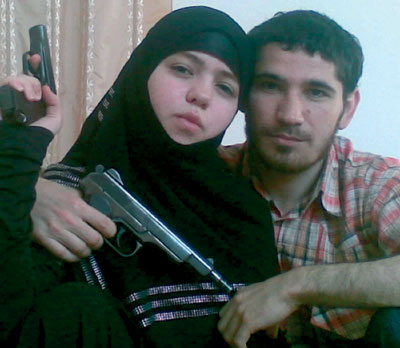
No longer can we expect terrorists to be a certain race, age or gender. The arrests in the US of Jihad Jane and Jihad Jamie, white western women who supported global jihad, as well as the increase in the number of women participating in all levels of terrorist organisations show us that women are becoming key players, even in the most seemingly chauvinistic and male-dominated terrorist organisations like al-Qaeda. Anwar al-Awlaqi, the American-born al-Qaeda propagandist recently assassinated by the US in Yemen, was considered to be progressive when it came to women’s involvement in terror, providing inspiration, for example, to Roshonara Choudhry, who made the failed assassination attempt on MP Stephen Timms in May 2010.
Female terrorists can have significant advantages over their male colleagues. Women operatives are able to maintain the element of surprise because there is no real profile of a female suicide bomber. Bombers have ranged in age from teenagers to a grandmother. If they have the choice, some organisations will select more attractive women, partly because they know that female bombers generate eight times the amount of media attention. Conversely, traditional clothes like the niqab and the salwar kameez allow a bomb to be effectively hidden and might even give the impression of a late-term pregnant woman, which is also an effective disguise. The attacks against the Moscow subways and airports in the past two years suggest the effectiveness of women bombers. Teams of women working in tandem managed to kill dozens of people at high-value targets that had been previously targeted and were supposedly well guarded.
Yet women’s involvement in terrorism is hardly new. Historically women have been involved in political violence at least since the Russian anarchists at the turn of the century. One of the first people ever tried for terrorism was Vera Zasulich, for her attempted assassination of Theodore Trepov, the governor of St Petersburg, in 1877.
Many women were involved in the anti-colonial terrorism of the 1960s and 1970s, from the women in the Mau Mau in Kenya to those fighting for Algerian independence.
Sometimes women rose to the highest echelons of leadership, as in the German communist Baader-Meinhoff Group, named in part after co-leader Ulrike Meinhoff. The Red Zora faction, a German militant group of the 1970s, was completely female and women were active in many of the terror organisations of the day, like Leila Khaled in the Popular Front for the Liberation of Palestine or Mairead Farrell in the Provisional IRA.
What has changed is the nature of women’s involvement and the mechanisms for recruitment. Why women join terrorist groups varies widely, but in general terms the female terrorists of the late 20th century joined voluntarily. Women in the Provisional IRA, according to interviews for my book, were never forced and many Tamil women in Sri Lanka were equally enthusiastic participants. This continues to be the case with women terrorists in Chechnya, and with Hamas, where women actually lobbied for the right to participate alongside men. But a new phenomenon has emerged with the coercion of women into terrorism by jihadi groups. The vast majority of the female suicide bombers in Diyala province in Iraq, for example, were selectively targeted and then raped before being given no option but to become bombers. The Sunday Times reported that a woman named Samira Ahmed Jassim organised the rape and recruitment of 80 women in this way.
Women’s roles have been much debated in jihadi circles. In December 2009, Umayma al-Zawahiri, wife of Osama Bin Laden’s successor as al-Qaeda chief, Ayman al-Zawahiri, issued an open letter to her sisters in Islam stating that women could participate in jihad, even as suicide bombers. Significantly, since Mrs Zawahiri’s letter went public, a number of websites and publications have emerged that encourage more women to take an active role in jihad. In the future it seems likely we will be seeing more female terrorists, both coerced and voluntary.
But jihadis may not stop there. Intelligence reports suggest the next group targeted for recruitment will be children.
Mia Bloom’s book Bombshell: The Many Faces of Women Terrorists is published by Hurst

